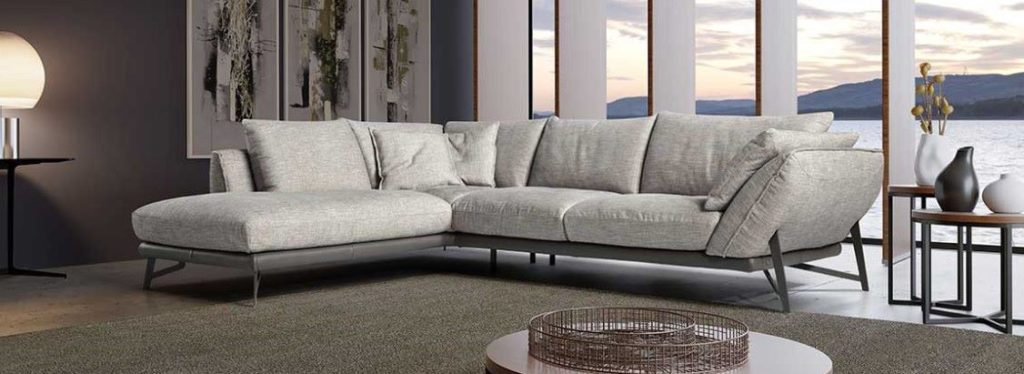

All types of furniture with fabric upholstery should be kept away from any sources of heat and direct sunlight, so as to avoid fading and potential scorching or burning. Treat spills as soon as they happen to avoid permanent damage. Fresh stains are also easier to remove. Be aware that certain dyes in clothes, particularly blue jeans, can transfer onto white or light-colored fabric furniture.
Day-to-Day Care
Furniture that is used regularly should be vacuumed or brushed frequently, generally once a week, as a preventative measure to avoid build-up of dirt and dust. Using the upholstery brush attachment on your vacuum is a great way to clean your fabric furniture safely. If regular vacuuming and dusting doesn’t seem to thoroughly clean the fabric, you can use a fabric cleaner for an extra boost to fully remove build-up. In general, you should use a fabric cleaner every three months or so. If you have any questions about how to properly maintain your fabric furniture, contact a professional cleaning service.
Cleaning
Immediately after something is spilled on your furniture, blot the spill as best you can. To prevent the stain from spreading, start cleaning the soiled area from the outside and then work your way towards the middle. To clean the stain, use a mild, water-based detergent such as laundry soap, on a cloth and clean with a circular movement. Always test cleaners on an inconspicuous area, like the back of a sofa, before using on the entire piece. Avoid using household cleaners and solvents on your furniture, as they can damage the fabric or make the spill worse. For the same reason, do not use hot water extraction or steam-cleaning on your furniture. If you have a large or stubborn stain, consider contacting a specialist cleaning company.
When it comes to choosing a fabric, there are a number of factors to consider, including price, color, texture, style, and more. However, there are two main things to think about when it comes to the fabric itself. First and foremost, what is the fabric made of? And how durable is it? Asking these two questions ensures you know exactly what you’re dealing with, and how to care for it. To help pick the furniture that is most suitable for your needs, check out our definitive guide on fabric types and durability below.
Cotton
Cotton is a natural fiber made from plants that is durable, soft, and breathable. It is naturally hypoallergenic and is resistant to wear, fading, and pilling. Cotton and cotton blends are ideal for those desiring a high-quality fabric at a lower price point. It is prone to wrinkling and tends to hold in stains, but since cotton is an easy-care material, stains are typically easy to wash out.
Wool
Wool is an environmentally friendly natural fiber that comes from animals. It is very durable, soft, and warm, and is fire and water-resistant. It resists wrinkling and pilling. Stains can take a long time to dry and be removed. However, some people can be sensitive to wool and may find it itchy. Blending wool with other materials, like synthetics, can help negate this effect. Wool is perfect for those in cooler climates or for people who like to stay cozy all year long.
Linen
Linen is a natural fiber made from the flax plant. It has a smooth and soft feel, is very durable, and is naturally antibacterial. However, linen is prone to wrinkling and stains, and can shrink if cleaned improperly. Make sure to follow cleaning instructions carefully or consult a professional. Linen’s breathable nature makes it ideal for keeping cool and comfortable in hotter climates.
Polyester
Polyester is a synthetic microfiber fabric. It is soft, stain-resistant, fade-resistant, wrinkle-resistant, and is easy to clean and dries quickly. It resists absorbing smells. However, it is not very breathable, can stretch over time, and is flammable. Make sure to avoid having open flames near polyester! When other fabrics are blended with polyester, they will be more durable, less prone to wrinkles and fading, and easier to clean.
Rayon/Viscose
Rayon, also known as viscose, is a semi-synthetic fiber. Typically made from wood pulp, it was originally made to imitate materials like silk, cotton, and linen. Rayon is very soft and can be very durable, and it is resistant to mildew. However, rayon is prone to wrinkling and pilling, and is not water-resistant. It can be versatile and long-lasting as long as you carefully follow care instructions.
Furniture upholstery is typically made from a blend of different materials. A blend of both synthetic and natural materials can give you the best of both worlds when it comes to fabric benefits.
Abrasion
The Martindale rub test is a common way of testing upholstery fabrics for resistance to abrasion. Sandpaper or wool is rubbed in circles across the fabric by a machine until the fabric starts to show signs of wear. The fabric is then scored to indicate the level of durability, with a higher score meaning the fabric is more durable and a lower score meaning the fabric is less durable.
Scoring Chart:
Pilling
Fabric’s pill resistance is rated in five “classes,” with Class 1 being very severe pilling and Class 5 being no pilling. A nylon bristled brush or sponge pad rubs the fabric in a circular motion to test the level of pilling, and the fabric is then rated on the 1-5 scale based on the severity of the pilling.
For rating details on other specific items, please contact your nearest Copenhagen location. Please be aware that not all items may have available ratings.